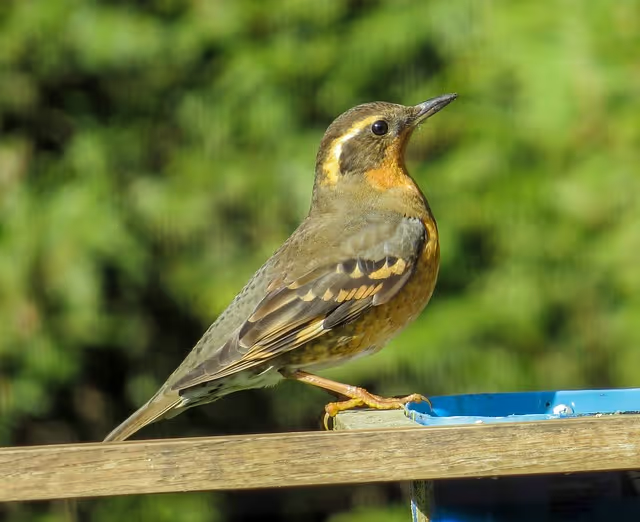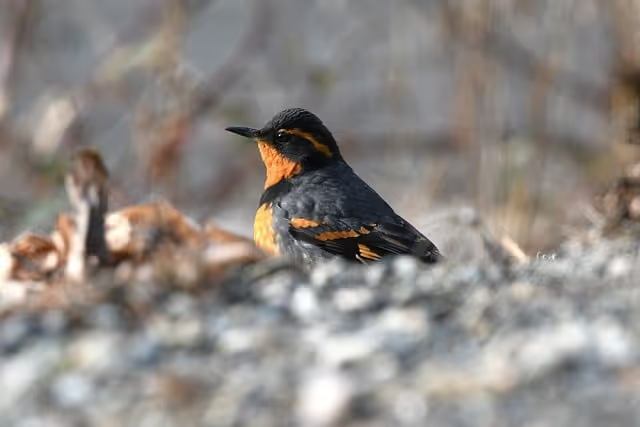The Varied Thrush


Introduction
The next time you encounter a robin, it might not actually be a robin. It may be a Varied Thrush (Ixoreus naevius) instead.
Varied Thrushes and robins are sometimes confused with each other due to their similar appearances, similar sizes, and being members of the same family (Turdidae) (2, 4, 5). Additionally, Varied Thrushes have been known to forage in flocks of robins (4). Fortunately, there are some characteristics that are unique to Varied Thrushes that may help you be able to distinguish these beautiful birds from their robin counterparts.
Physical Characteristics
Varied Thrushes are “stocky” songbirds with long legs, rounded heads, short tails, pointed wings, and straight bills (1, 3). They often appear to look “plump-bellied”, and typically stand in a horizontal fashion (3). Members of both sexes are 7.5 to 10.2 inches long (19 to 26 centimeters), with a wingspan of 13.4 to 15 inches (34 to 38 centimeters). They typically weigh 2.5 to 3.5 ounces (65 to 100 grams) (3).
Color Patterns
Male Varied Thrushes are especially beautiful birds, thanks largely to their bold color patterns. Their backs are a mix of dark blue and gray, while their bellies are a rich shade of burnt orange (3). They have a soot shaded black breastband, and an orange line over their eye (3). These features almost make them look like they wearing a mask, which has inspired generations of children to call them “robber birds” (5). Their wings are mostly blackish in color. However, they do have two striking orange bars and orange edging on their flight feathers (3).
Female Varied Thrushes have the same color patterns as males, though their appearance isn’t as bold as they feature more pale shades of gray and brown (3). They still look magnificent nonetheless.
Juvenile Varied Thrushes have the same color patterns as adults, with the only difference being that their chests are mottled (1).
Diet
Varied Thrushes mostly consume a diet of insects and berries. Insects dominate their meals during the summer, with caterpillars, crickets, ants, and beetles among their favorites (1). Sowbugs, snails, earthworms, and spiders also feature regularly on their summer menus (1). During the winter, berries and wild fruits become the dominate sources of meals. Seeds and acorns are also eaten at this time of year (1).

Image by radesigns from Pixabay
Behavior
Varied Thrushes forage for their food on the ground. They typically prefer to hunt under dense cover, but may use open lawns from time to time. They sometimes use their bills to throw leaf-litter aside as they search for insects (1).
Varied Thrushes are routinely aggressive towards each other, as well as other bird species (2). At bird feeders, males will sometimes defend small feeding territories, where they can particularly dominate sparrows, cowbirds, towhees, blackbirds, and juncos (2). That being said, they prefer not to mess with California quails, western scrub-jays, northern flickers, and American robins (2).
As we mentioned earlier, Varied Thrushes sometimes forage for food with robins. However, this only happens when they are looking for barriers or earthworms on lawns (2).
Range
Varied Thrushes have a broad range of territory in which they call home. They can be found as far north as Interior Alaska, and as far south as Baja California (1).
Here on the Washington Coast, you can find Varied Thrushes year-round. Additional year-round habitat for Varied Thrushes can be found throughout western Washington, western Oregon, Vancouver Island, western portions of mainland British Columbia, northern Idaho, northeast Washington, north-central Washington, and northwest California (1).
During their annual breeding season, you can find Varied Thrushes throughout all but the far northeast corner of British Columbia, Yukon Territory, and most of Alaska (1). They spend much of the year in these places, arriving early in the spring and leaving late in the fall (1).
During the winter, Varied Thrushes can be found along the entire California Coast, in interior portions of northern and central California, in Baja California, in central Oregon, and in south-central Washington (1).
Habitat
Varied Thrushes like to make their homes in areas of thick, wet, coniferous forest. They particularly like coastal areas, as well as areas with hemlock, spruce, and fir trees that feature dense understory (1). During the winter, they may also reside in the undergrowth of non-coniferous woods, particularly near streams (1).
Nesting
Varied Thrushes typically make their nests in conifer trees. They are placed at the base of branches up against the tree trunk (1). They are normally located approximately five to fifteen feet above the ground, though this can vary, especially in the far northern parts of their range (1). When suitable conifer trees aren’t available, Varied Thrushes may opt for very low spots in deciduous thickets or nest directly on the ground (1). The nest is believed to be built exclusively by the female. It is an open, bulky cup of bark fibers, leaves, twigs, and moss. It is lined with rootlets and grass (1).

Image by Veronika Andrews from Pixabay
Eggs and the Young
Varied Thrushes typically lay three to four eggs at a time. The eggs are pale blue in color with a light coating of brown dots (1). The incubation process is handled solely by the female, and is believed to run for about two weeks (1). When the young hatch, both parents share in the responsibility of feeding them (1). Unfortunately, little is known about how the young develop and the age at which they leave the nest. It is suggested that Varied Thrushes produce two broods of young each year (1).
Finding the Varied Thrush
In forested areas, your first clue that a Varied Thrush is nearby may be its song, which you can listen to here[youtube.com]. This song has been described by Louis Agassiz Fuertes, a renowned twentieth-century bird artist as being “perfectly the voice of the cool, dark peaceful solitude which the bird chooses for its home as could be imagined” (2). When these birds are singing, they will most likely be at higher perches in the understory and lower layers of the forest. If they are foraging, look for them in small openings on the ground (2). During the winter, they’ll turn up at bird feeders (2).
References
© Ian Caldwell, March 2024
Touch whale bones, examine shipwreck artifacts and connect with the coast's living history.

Support our mission, get involved in educational programs, or contribute through donations and volunteering.